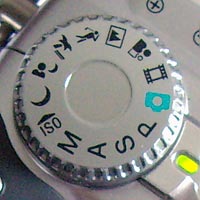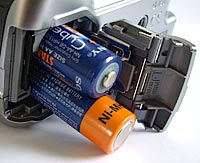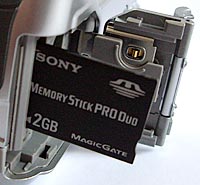Sony Cybershot DSC-H2 Review
Review Date: September 11th 2006
Author: Gavin Stoker
Leave a comment about this Review
|
Ease of Use
Sony's latest SLR-styled bridge camera is a strange beast, out to satisfy two distinct and, you'd imagine, wholly separate groups: beginners and photo enthusiasts. This means that, while the Sony Cybershot DSC-H2 features a plethora of photographic controls to meet the wants of more demanding users, it's also surprisingly easy to use, and just might tempt those who feel the need for a 12x optical zoom (equivalent to 36-432mm in 35mm terms and sporting Carl Zeiss optics) away from more fashion-conscious compacts.
Given this range, the Sony Cybershot DSC-H2 boasts much needed optical image stabilization in the form of Super SteadyShot mode. There's the option to set the camera to adjust continuously for hand wobble and resultant image blur, disable it, or activate it only on an individual shot basis. Picking the chunky camera up, the initial impression is that not much has changed since last year's H1, save that the resolution has been boosted to six megapixels, while perversely the LCD has shrunk from 2.5 to 2-inches. This is offset somewhat by the inclusion of a higher resolution, 200,000 pixels electronic viewfinder (EVF).
Despite the plastic looks – accentuated by the metallic silver finish, where a black casing would have disguised them better – the Sony Cybershot DSC-H2 feels sturdy when gripped, thanks in part to the weight of the two rechargeable Stamina AAs that power it being stored within the rounded grip itself. The EVF hood juts back from the main body, mimicking not only Konica Minolta bridge cameras from the recent past but also the art deco spaceships of early Flash Gordon serials; in a subconscious way suggesting that although the Sony Cybershot DSC-H2 is packed with latest technology, there's much here that's non-threatening and familiar. Unfortunately the pronounced hood also means it's difficult to get your eye flush to the camera if wearing any kind of glasses.
Fortunately the rest of the Sony Cybershot DSC-H2 is more ergonomically sound. Immediately below the EVF is the aforementioned bright and clear LCD – though its size and resolution (at just 84,960 pixels) could be improved – to the left of which is AV-out and USB port, with pop-open cover. To the right of the screen sits a button serving the dual function of selecting image quality or deleting shots. Above is a familiar four-way control dial. Apart from allowing users to thumb through and effect menu options, the dial additionally allows selection of flash, macro and self-timer modes, plus manual exposure adjustment (+/- 2.0EV in 1/3EV increments) on the fly. Immediately above are two buttons for turning on the display and calling up the bright, blocky menu system that has reminded unchanged through several generations of Cyber-shots. Still, if it ain't broke…
| Navigation Pad | Mode Dial |
 |
 |
Up top is a springy and responsive rocker switch for the zoom, to the left of which is a button for playback and an adjacent one for swapping between LCD and EVF for shot composition and review. In front of these, and slightly recessed to prevent accidental activation, are a button for switching on/off Super SteadyShot and another for switching on/off the camera itself. To the right is a bottle-top mode dial, veritably crammed with shooting options. These include full auto capture for the point and shoot brigade, plus program, shutter speed priority and aperture priority, manual exposure, ISO sensitivity (incrementally from ISO80 to ISO1000) along with six scene presets for slow shutter, low light shooting without flash, low light portraits with flash, enhancing beach/sea shots (by boosting the quotient of blue), plus high speed shutter for action/sports, landscape and standard portraits. The final mode, denoted by a frame of film, is for MPEG1 video capture, which starts and stops with a firm press of the shutter button.
Just forward of the dial are buttons for activating the continuous shooting modes – burst, exposure bracketing or multi burst (the latter offering up to 16 frames in succession) – plus selecting alternative (to full auto) focus modes: multi point AF, centre AF, flexible spot AF or manual. The latter brings up a distance focus bar on screen, ranging from 2cm to infinity. Finally, sitting forward of this at the front of the sloping grip is the main shutter button, with an SLR-style jog dial resting just below. This allows on-the-fly adjustment of manual and exposure settings, plus doubles up as a means of scrolling through captured images.
With a press of the power button the Sony Cybershot DSC-H2's LCD – or EVF, if that was the option previously chosen – is activated, the lens barrel extending fully to maximum wide-angle setting. This means a wait of around three seconds before it's ready to take a shot. Essential settings displayed on the LCD (or viewfinder) in full auto mode include pixel count and image quality, card capacity (denoted by number of remaining images), battery life indicator, flash setting and AF mode (with a choice of single, monitor or continuous AF). A press of the display button brings up a useful live histogram display.
Turning the mode dial a notch to the P/A/S/M options adds whatever settings have been manually selected to the screen – white balance and ISO speed for example. Also adjustable in these modes, via a familiar grey toolbar that runs across the bottom of the screen, are colour settings – the default being ‘normal', though vivid, natural, sepia and black and white are also offered. Metering (spot, centre or multi), picture quality (fine or standard), contrast and sharpness settings are also adjustable via this bar. Tab along to the far right of the bar in any mode and you reach a familiar set up icon. A further press of the four-way control dial brings up several self-explanatory set up screens, allowing for activation or deactivation of the camera's supplementary functions, such as digital zoom, AF illuminator, red eye reduction, SteadyShot and so on. You can also format the memory, set the clock and tinker on a basic level. Useful, in that you don't have to leave whichever shooting mode you're in to return to set up options. It has to be said that operation is intuitive and the Sony menu systems are some of the easiest to navigate among digital compacts.
| Battery Compartment | Memory Card Slot |
 |
 |
Though strong sunlight affects the Sony Cybershot DSC-H2's main LCD as much as the next digital camera, being able to fall back on the EVF is a boon for non-spectacle wearers. The quality's pretty good, in spite of having to squint to read the small display, and of course a backlight can be activated if you find yourself struggling in adverse lighting conditions. Once the camera has determined focus with a half press of the shutter button, image capture is nigh on instantaneous, while in single shot capture mode there's barely a blink between one full resolution JPEG image being written and the Sony Cybershot DSC-H2 being ready to take the next (there's no TIFF or RAW options). Swift operation is no less than you'd expect from a bridge camera (or ‘super zoom') of course, but don't forget that the Sony Cybershot DSC-H2's keen pricing also makes it a viable alternative to a regular point and shoot compact.
One area the Sony Cybershot DSC-H2 perhaps falls down on is battery life. Constantly swapping between LCD and EVF, and opting for continuous image stabilization, never mind all the back and forth with the zoom, sucks power. The inclusion of two Stamina NiMH AAs is arguably no match for a dedicated lithium ion cell, and I would conclude that Sony's claim for a life of 400 shots is over-optimistic. Still, they're quick to recharge or easy to replace if you haven't got access to do that – for example when holidaying abroad.
Switching to playback mode, you automatically get image and folder number displayed on screen, along with time and date of capture and the omnipresent battery life. Press the display button and you get additional information on ISO speed, flash setting, chosen exposure, plus a histogram by way of graphic representation. Select the menu option and you get the opportunity to rotate an image in camera if so desired, plus all the regular set up options accessible in the other capture modes.
As mentioned earlier, the Sony Cybershot DSC-H2 has a feature set that's at once comprehensive and user friendly. Those getting to grips with a bridge camera for the first time can gradually introduce more manual control as their experience grows, with clear logical displays and intuitive navigation ensuring they won't be frightened off from exploring further. The more experienced user has the following sobering fact to contend with: the Sony Cybershot DSC-H2 is still roughly half the price of a Sony Alpha D-SLR with kit lens. Though we all lust for glory, economics dictates that most of us are sadly left dreaming. One thing's for certain though: the Sony Cybershot DSC-H2 arguably now offers photographers a far better deal than the Cybershot R1, also from Sony.
|
![]() PhotographyBLOG
is a member of the DIWA
organisation. Our test results for the Sony Cybershot DSC-H2
have been submitted to DIWA
for comparison with test results for different samples of
the same camera model supplied by other DIWA
member sites.
PhotographyBLOG
is a member of the DIWA
organisation. Our test results for the Sony Cybershot DSC-H2
have been submitted to DIWA
for comparison with test results for different samples of
the same camera model supplied by other DIWA
member sites.
